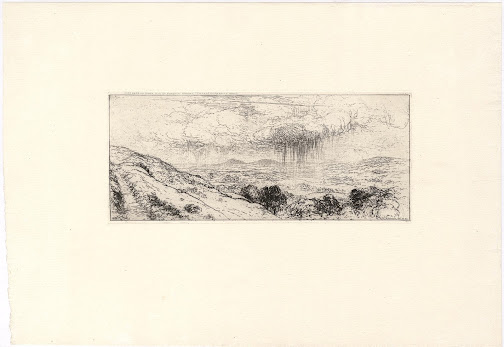Sir John Charles Robinson (1824–1913)
“Nine Barrow Down, Isle of Purbeck, looking towards St Alban's Head”, 1872, a view etched on location (“on the spot”) in reverse (see https://collection.beta.fitz.ms/id/image/media-218326). I understand that this scene is close to where the artist resided in his last years near Swanage, Dorset (see https://collections.tepapa.govt.nz/object/41901).
Etching on cream laid paper (Arches watermark) with wide margins as published.
Size: (sheet) 29.5 x 43 cm; (plate) 11.3 x 26.1 cm; (image borderline) 10.8 x 25.7 cm.
Inscribed in plate: (above the image borderline at upper left) “NINE BARROW DOWN, I[S]LE OF PURBECK, LOOKING TOWARD[S] ST. ALBAN[S] HEAD.”; (within the image borderline at lower left corner) “1872”; (within the image borderline at lower right corner) “J.C. Robinson del. et sc.”
State iii (of iii) with “the lines of rain broken up by the burnisher” (state ii) and with the addition of the publication details (state iii).
Hind 12 iii/iii, PCQ Vol 8, No 3, 1921; illustrated page 306; H.167.
The British Museum offers the following description of this print:
“Spreading landscape with rain
falling from heavy clouds. 1872
Etching” (https://www.britishmuseum.org/collection/object/P_1925-0314-77).
The Annex Galleries offer the following information regarding this print:
“Sir John Charles Robinson, a close
friend of Seymour Haden, was Superintendent of Collections at the South
Kensington Museum and Surveyor of the Queen's pictures. He was a noted
collector and curator and was a founder of the Fine Art Club and the Royal
Society of Painter Etchers (with Francis Seymour Haden).
In his catalogue of Robinson's prints Arthur Hind notes, while discussing Robinson's use of atmosphere that in the etching Nine Barrow Down, ‘We can see that the scraper and burnisher have been used to break up the straight etched lines making the rays of light coming from the sun; thus giving the effect of moving light and the haziness of dawn.’
Nine Barrow Down is an elongated hill forming the northern ridge of the Purbeck Hills on the Isle of Purbeck in Dorset, England. The chalk down is part of the extensive Southern England Chalk Formation. The eastern end of the ridge, which carries the highest point, is also sometimes known as Godlingston Hill. The col of the railway cutting at Harman's Cross means that it has sufficient relative height that it qualifies as a ‘Marilyn’” (https://www.annexgalleries.com/inventory/detail/17507/John-Charles-Robinson/Nine-Barrow-Down-Isle-of-Purbeck-Looking-Towards-St-Albans-Head).
Condition: a richly inked and near faultless impression with generously wide margins in near pristine condition with no tears, holes, folds, abrasions, significant stains, foxing or signs of handling.
I am selling this magnificent etching—a true printmaker’s print! —executed on location showing rain being shed from heavy clouds in a vast panorama, for the total cost of AU$279 (currently US$202.60/EUR172.90/GBP148.09 at the time of this listing) including postage and handling to anywhere in the world, but not (of course) any import duties/taxes imposed by some countries.
If you are interested in purchasing this sublime etching that takes my mind to Constable and Rembrandt, please contact me (oz_jim@printsandprinciples.com) and I will send you a PayPal invoice to make the payment easy.
This print has been sold











No comments:
Post a Comment
Please let me know your thoughts, advice about inaccuracies (including typos) and additional information that you would like to add to any post.